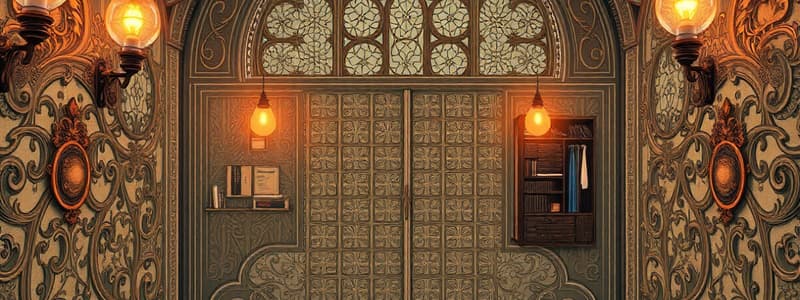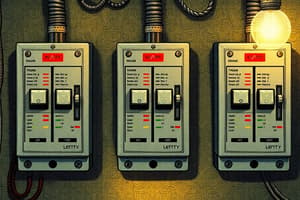Podcast
Questions and Answers
What can result from damaged insulation in electrical wiring?
What can result from damaged insulation in electrical wiring?
Damaged insulation can lead to electric shocks and fire hazards due to short circuits.
How does overheating of cables pose a hazard?
How does overheating of cables pose a hazard?
Overheating occurs when high currents pass through thin wires, potentially melting insulation and causing fires.
What is the function of a fuse in an electrical circuit?
What is the function of a fuse in an electrical circuit?
A fuse protects the circuit by melting and breaking the connection if the current exceeds a certain level.
In what way do circuit breakers improve upon fuses?
In what way do circuit breakers improve upon fuses?
What is the purpose of an earth wire in electrical appliances?
What is the purpose of an earth wire in electrical appliances?
How does double insulation prevent electric shocks?
How does double insulation prevent electric shocks?
What is the relationship between power (P), current (I), and voltage (V) in electrical systems?
What is the relationship between power (P), current (I), and voltage (V) in electrical systems?
What formula expresses the energy transferred in an electrical circuit over time?
What formula expresses the energy transferred in an electrical circuit over time?
What is the key difference between alternating current (a.c.) and direct current (d.c.)?
What is the key difference between alternating current (a.c.) and direct current (d.c.)?
How is current defined in terms of charge and time?
How is current defined in terms of charge and time?
What unit is used to measure potential difference, and what does it signify?
What unit is used to measure potential difference, and what does it signify?
Describe the relationship between potential difference, current, and resistance in an ohmic conductor.
Describe the relationship between potential difference, current, and resistance in an ohmic conductor.
What happens to the resistance of a filament lamp as the current increases, and why?
What happens to the resistance of a filament lamp as the current increases, and why?
Explain the function of a thermistor in a circuit.
Explain the function of a thermistor in a circuit.
What is the principle behind a light-dependent resistor (LDR)?
What is the principle behind a light-dependent resistor (LDR)?
How can you describe the flow of current at a junction in a circuit?
How can you describe the flow of current at a junction in a circuit?
What is the total resistance in a series circuit with two resistors, R1 and R2?
What is the total resistance in a series circuit with two resistors, R1 and R2?
Why is a parallel circuit advantageous when connecting lamps?
Why is a parallel circuit advantageous when connecting lamps?
Define electric charge and how it is measured.
Define electric charge and how it is measured.
What occurs when two insulators are rubbed together?
What occurs when two insulators are rubbed together?
What is the relationship between current in a parallel circuit and the current through the source?
What is the relationship between current in a parallel circuit and the current through the source?
What is the effect of using conductors versus insulators in an electric circuit?
What is the effect of using conductors versus insulators in an electric circuit?
Explain the potential difference across components in a series circuit.
Explain the potential difference across components in a series circuit.
How can the danger of electrostatic charges be mitigated during fueling operations?
How can the danger of electrostatic charges be mitigated during fueling operations?
Flashcards
Fuse
Fuse
A safety device that melts to break a circuit if the current exceeds a certain value. It protects the circuit by preventing overheating.
Circuit Breaker
Circuit Breaker
A device that automatically breaks a circuit if the current exceeds a certain value. Unlike fuses, it can be reset and used again.
Earth Wire
Earth Wire
A wire that connects the metal casing of an appliance to the earth, providing a safe path for current to flow in case of a short circuit.
Double Insulation
Double Insulation
Signup and view all the flashcards
Power (P)
Power (P)
Signup and view all the flashcards
Energy (E)
Energy (E)
Signup and view all the flashcards
P = IV
P = IV
Signup and view all the flashcards
E = IVt
E = IVt
Signup and view all the flashcards
Direct current (DC)
Direct current (DC)
Signup and view all the flashcards
Alternating current (AC)
Alternating current (AC)
Signup and view all the flashcards
What is electric current?
What is electric current?
Signup and view all the flashcards
What is potential difference?
What is potential difference?
Signup and view all the flashcards
What is resistance?
What is resistance?
Signup and view all the flashcards
What is an ohmic conductor?
What is an ohmic conductor?
Signup and view all the flashcards
What is a non-ohmic conductor?
What is a non-ohmic conductor?
Signup and view all the flashcards
What is a thermistor?
What is a thermistor?
Signup and view all the flashcards
Series Circuit
Series Circuit
Signup and view all the flashcards
Resistance in Series
Resistance in Series
Signup and view all the flashcards
Parallel Circuit
Parallel Circuit
Signup and view all the flashcards
Current in Parallel
Current in Parallel
Signup and view all the flashcards
Voltage in Parallel
Voltage in Parallel
Signup and view all the flashcards
Coulomb
Coulomb
Signup and view all the flashcards
Conductor
Conductor
Signup and view all the flashcards
Insulator
Insulator
Signup and view all the flashcards
Study Notes
Mains Electricity
-
Hazards:
- Damaged insulation: Contact with wires with gaps in insulation can cause electric shocks or start fires (short circuits).
- Overheating of cables: High currents in thin wires cause overheating, potentially melting insulation and starting fires.
- Damp conditions: Water conducts electricity, increasing risk of electric shocks.
-
Fuses and Circuit Breakers:
- Fuses: Thin wires that melt if current exceeds a safe level, protecting the circuit.
- Circuit Breakers: Automatic switches that break the circuit when current goes too high, providing a safer alternative to fuses. They are faster and reusable.
-
Earthing Metal Cases:
- Earth wires: Provide a low-resistance path for current in case of a short circuit, preventing electric shocks.
- Strong current surges through the earth wire, breaking the fuse and disconnecting the appliance to prevent damage.
-
Double Insulation:
- Appliances with double insulation have plastic casings or have been designed such that the earth wire cannot touch the metal casing, preventing electric shocks.
Electrical Transfer of Energy
- Energy: Measured in joules (J). Transferred from chemical energy in a battery to electrical energy used by circuit components, and then to the surroundings.
- Power: Measured in watts (W). P=IV or P=I²R or P=V²/R
- Energy transferred, E=IVt
Alternating Current and Direct Current
- Direct Current (DC): Flows in one direction.
- Alternating Current (AC): Continuously changes direction.
- Mains electricity is AC; a cell or battery's power is DC.
Energy and Voltage in Circuits
-
Current:
- Measured in amperes (A).
- The rate of flow of charge (I = Q/t).
- In metals, it is due to the flow of electrons (conventional current opposite to the electron flow).
- Conserved at junctions in a circuit.
-
Potential Difference:
- Measured in volts (V).
- Work done per unit charge (V = E/Q).
- Measured using a voltmeter placed in parallel across the component.
- Higher potential difference results in higher current.
-
Resistance:
- Measured in ohms (Ω).
- R = V/I
- Higher resistance means more difficult current flow.
- Ohmic conductors have constant resistance.
- Non-ohmic conductors (like filament lamps) have resistance that changes with current and voltage.
Electric Circuits
-
Series Circuits:
- Components connected end-to-end.
- Same current flows through all components.
- Potential difference is shared among components (sum of voltages = total voltage).
- Total resistance (R) equals the sum of individual resistances (R₁+ R₂...).
-
Parallel Circuits:
- Components connected to the power supply in separate branches.
- Current is shared among branches (sum of branch currents = total current).
- Potential difference is the same across every branch.
- If one component fails, current can still flow through other components.
Electric Charge
- Measured in coulombs (C).
- Unlike charges attract; like charges repel.
- Charging a body is adding or removing electrons.
- Conductors allow electron flow; insulators resist electron flow.
- Rubbing two insulators together can transfer electrons, creating a charge.
- Various applications based on static charges (e.g., inkjet printers, photocopiers).
Studying That Suits You
Use AI to generate personalized quizzes and flashcards to suit your learning preferences.




